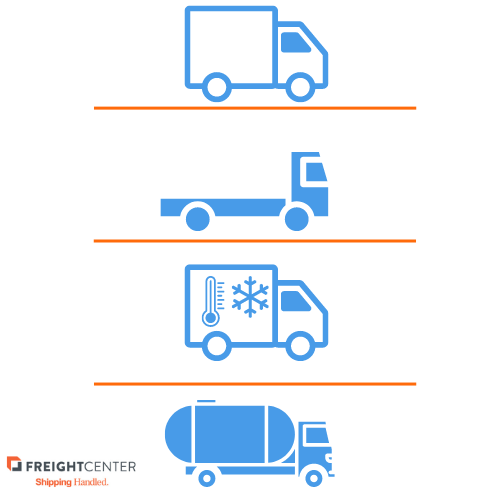What Are Trucking Segments?
When it comes to the logistics and transportation industry, there are many different factors that make up what it takes to get the job done.
A key player is the trucks that transport various types of freight from its origin to its destination. With hundreds of different kinds of products being transported daily across the globe, different carriers and truck types are needed.
The trucking industry can be segmented in several ways: carrier type, cargo type, truck type, commodity, and operating distance. All these segments have unique characteristics that cater to the specific needs of shippers.
Whether you’re interested in a career in trucking, a business owner, or simply just interested in the trucking industry, FreightCenter has you covered on everything you need to know about trucking segments.
Commodities
What exactly can be shipped, and how is it categorized? There are many different kinds of commodities that are transported. Commodities are basic goods and materials that are widely used. Here are some commodities:
- Agricultural Commodities: Includes livestock and harvested food and goods
- Heavy Haul: Equipment and machinery
- Motor Vehicle: Trucks, vans and cars
- Building Materials: Cement, lumber and steel
- Household Goods: Clothing and electronics
- Bulk: Petroleum, hazardous materials, and food-grade liquids
- Refrigerated: Pharmaceuticals and food
So, for example, if you need to ship a box of sweaters or shirts, it would be considered a household good commodity. Understanding what commodity your shipment falls under is essential for ensuring it is transported in the correct truck.

Cargo Types
Similar to commodity types, cargo types are able to determine how the products should be properly transported. There are typically four cargo types that a shipment can fall under:
- General: Refers to goods that need to be transported in bags, barrels, boxes, etc.
- Bulk Dry: Goods that are shipped in unprocessed, raw forms, such as minerals and grains.
- Bulk Liquid: Goods that are shipped as liquids, such as chemicals and oils.
- Refrigerated: Refrigerated cargo is the kind that requires transportation in a temperature-controlled trailer.
Carrier Types
Depending on what is needed to properly manage the shipment, there are various carrier types that are used to transport the freight. Some of them you may already be familiar with.
- Less-Than-Truckload (LTL): LTL is typically the most popular carrier type out of all of them. Less-Than-Truckload is used when one shipment won’t take up the entire trailer, therefore a trailer is filled with cargo from multiple sources and dropped off at multiple locations. This type of carrier ensures that a trailer is used to its full capacity so there are no empty miles in a transport.
- Full Truckload (TL): Full Truckload is used when a shipment takes up the space of a full truck trailer. Examples of this can be shipments of heavy equipment, a large number of palletized freight, or large retail shipments for seasonal inventory. TL shipments have only one stop, which can minimize the risk of damage and reduce handling time.
- Specialized Carriers: In trucking, specialized carriers focus on specific types of cargo that need unique requirements. This includes services such as temperature-controlled trailers or white glove services, typically used for antiques or expensive freight.
- Courier Services: Courier services are often within urban areas and offer quick, small-package delivery. Courier services are usually handled by carriers such as FedEx, UPS, or the US Postal Service. Recently, courier delivery has sometimes been included within last-mile delivery classifications.
Truck Types
There are various types of trucks for different purposes.
- Dry Van: A dry van is the most common type of truck and is what you would most commonly see driving down the highway. A dry van has a 53-foot trailer and hauls general freight.
- Flatbed: A flatbed is used for oversized freight, automobiles, or construction materials. It is a flat and open trailer. Any freight that needs to be transported via a flatbed trailer has to be secured with tarps, straps, and other locking devices.
- Reefer: A reefer is a refrigerated truck used to transport freight that needs to be in a temperature-controlled environment.
- Tanker: A tanker truck has a cylinder-shaped trailer and is used to transport dry or liquid bulk cargo such as gasoline, etc…

Operating Distance
Not only do trucking segments characterize the type of freight and the transportation method, but also the distance that the cargo needs to travel. There are three kinds of operating distances.
- Local: Local truckers operate close to their homes, delivering cargo within a day.
- Regional: Regional distance is also commonly known as short-haul. Truckers that operate regionally travel within a few states in a general area. The drivers operate within a 250-mile radius.
- Long Haul: Long-haul trucking is also called over-the-road trucking and is the kind where truckers spend weeks on the road. Long haul covers a distance of 250 to 1,000 or more miles.
Each type of trucking segment offers distinct advantages tailored to unique shipping needs, whether you’re shipping specialized cargo, time-sensitive goods, or bulk shipments.
Understanding the types of trucking segments can help you efficiently manage logistics and supply chain operations while ensuring that your freight is safely transported and delivered.


